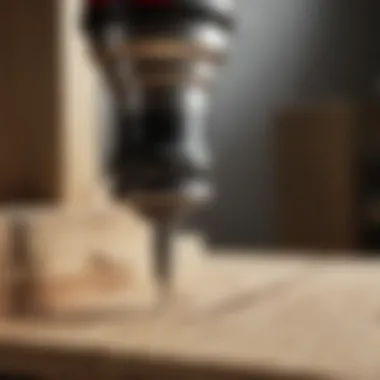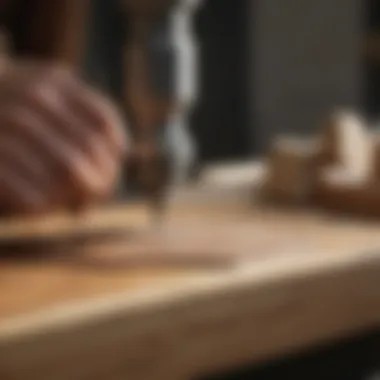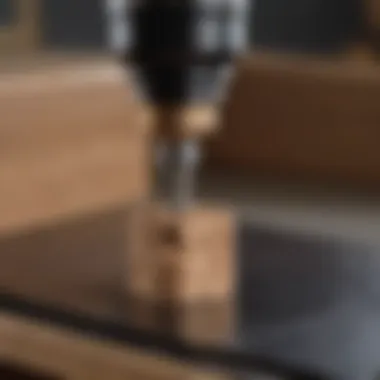Discovering the Finest Roundover Router Bits for Precise Woodworking Results


Woodworking is a craft that demands precision and attention to detail, and one tool that plays a crucial role in achieving immaculate finishes is the roundover router bit. These small, yet powerful tools are designed to create smooth, curved edges on wooden surfaces, adding a touch of sophistication to any project. Whether you are a seasoned woodworker or just starting out, understanding the intricacies of roundover router bits can elevate your woodworking game to new heights.
Overview of Topic
In the realm of woodworking and home improvement, roundover router bits are a staple tool for achieving flawless edges that exude professionalism and craftsmanship. These bits are specifically designed to add rounded edges to wooden pieces, providing both aesthetic appeal and functionality. By introducing subtle curves to sharp corners, roundover router bits soften the edges of furniture, cabinets, trim pieces, and various other woodworking projects, giving them a polished and refined look.
The importance of mastering the art of roundover router bits cannot be overstated in the realm of woodworking. Not only do these bits enhance the visual appeal of your projects, but they also contribute to the durability of wooden pieces by eliminating sharp edges that are prone to damage. Additionally, roundover edges make cleaning and maintenance easier, as they prevent dust and debris from collecting in hard-to-reach corners, thus prolonging the lifespan of your creations.
Common Challenges and Solutions
One common challenge faced by homeowners and DIY enthusiasts when working with roundover router bits is achieving consistent and smooth edges across all sides of a wooden piece. Inconsistencies in depth or pressure can result in uneven edges that detract from the overall appearance of the project. To overcome this challenge, it is crucial to practice proper technique, ensuring steady and even movements when using the router.
Another issue that may arise is tear-out or splintering along the edges of the wood, especially when working with hardwoods or veneered boards. To mitigate this, using a sharp router bit and moving at a steady pace can help minimize tear-out, while also ensuring a clean and precise cut. Additionally, employing sacrificial boards or backer boards can provide support to the wood fibers, reducing the likelihood of splintering.
Product Recommendations
When it comes to selecting the best roundover router bits for precision woodworking, [Industry Brand] stands out as a trusted name in the industry, offering a range of high-quality products to suit various woodworking needs. One top recommendation from [Industry Brand] is their XYZ Roundover Router Bit Set, which includes three different radius sizes to cater to different design preferences and project requirements.
The XYZ Roundover Router Bit Set features carbide cutting edges for long-lasting sharpness and precision, ensuring clean cuts and smooth finishes on all types of wood. These bits are designed for easy installation in most routers, providing versatility and ease of use for both beginners and experienced woodworkers alike. Whether you are working on furniture, trim, or decorative pieces, the XYZ Roundover Router Bit Set is a reliable choice for achieving professional results.
Step-by-Step Guides
To begin using roundover router bits in your woodworking projects, start by selecting the appropriate radius size based on the desired edge curvature. Next, ensure that your router is securely set up and adjusted for the desired depth of cut. Practice on a scrap piece of wood before moving on to your actual project to familiarize yourself with the tool and refine your technique.
When routing the edges of your project piece, make sure to move the router in the opposite direction of the wood grain to prevent tear-out and achieve a cleaner cut. Take your time and maintain a steady pace to ensure smooth and consistent results across all sides of the wood. Finally, sand the rounded edges to remove any roughness and achieve a seamless finish that enhances the overall appearance of your woodworking creation.
By following these step-by-step guides and recommendations, you can master the art of roundover router bits and elevate your woodworking projects to the next level, achieving precision and style in every detail.
Introduction
Roundover router bits are essential tools in the realm of woodworking, meticulously designed to craft smooth, decorative edges that elevate the aesthetic appeal of projects. These bits, with their precision engineering, play a crucial role in achieving flawless finishes and adding intricate details to woodwork. Whether you are a novice enthusiast or a seasoned woodcraft artisan, understanding the nuances of roundover router bits can significantly enhance the quality of your creations.
What are Roundover Router Bits?
Roundover router bits are specialized cutting tools used to shape the edges of wooden pieces, giving them a subtly rounded profile. This profile rounds off sharp edges, providing a smooth and visually appealing finish to furniture, cabinetry, and various wood projects. The functionality of roundover router bits lies in their ability to cut a convex semicircular profile along the edge of the material, leaving a polished and professional look.
- : prufile The excellent cutting precision and gradual edge transition offered by roundover bits are highly favored in woodworking circles for their ability to add sophistication to design elements effectively.
Definition and Function


The paramount significance of the 'Definition and Function' of roundover router bits rests in their capability to transform ordinary wood surfaces into elegantly curved edges. These bits smoothly round off harsh corners, enhancing the visual appeal and tactile comfort of furniture and other wooden structures. A distinctive feature of the 'Definition and Function' of roundover router bits is their ability to create seamlessly blended edge profiles, adding a touch of finesse to woodworking projects. While their primary advantage lies in achieving sophisticated finishes, one drawback could be the need for meticulous precision during operation to avoid over-rounding or inconsistencies in edge curvature.
Importance in Woodworking
The 'Importance in Woodworking' of roundover router bits cannot be overstated, as they contribute significantly to elevating the overall quality of woodcraft. They enable woodworkers to achieve seamless transitions between edges, ensuring not only visual appeal but also functional comfort. An essential characteristic of the 'Importance in Woodworking' is the efficiency with which these bits streamline the process of creating smooth, rounded edges, saving time and effort for craftsmen. However, users must exercise caution to prevent tear-outs or splintering, which can be a potential downside when working with certain wood grain orientations.
Benefits of Using Roundover Router Bits
Utilizing roundover router bits in woodworking projects offers a myriad of advantages that go beyond mere aesthetics. These benefits encompass not only the visual appeal but also the practical aspects of safety, creativity, and versatility.
Enhances Safety
One of the primary advantages of using roundover router bits is the enhancement of safety in woodworking. By softening sharp edges and corners, these bits reduce the risk of accidental cuts or injuries during handling, installation, or regular use of wooden items. The rounded profiles created by these bits add a comfortable feel to furniture pieces, eliminating potential hazardous points while enhancing user safety.
- : enhancemnt
Adds Aesthetic Value
Incorporating roundover router bits into woodworking projects adds significant aesthetic value by imparting a professional finish to edges. The smooth, rounded profiles crafted by these bits elevate the visual appeal of furniture, cabinets, and other wooden items, giving them a polished and refined appearance. This enhanced aesthetics not only enhances the overall look of the piece but also signifies attention to detail and craftsmanship.
Versatility in Edge Designs
The versatility of roundover router bits lies in their ability to create an array of edge designs, from subtle curves to more pronounced roundovers. This flexibility allows woodworkers to customize the appearance of their projects, adding creative flair and unique elements to their designs. The ability to experiment with different edge profiles enhances the creative potential of woodworkers, enabling them to bring their artistic vision to life in their creations.
Key Features to Consider
When it comes to selecting the best roundover router bits for precision woodworking, it is crucial to pay attention to several key features that can significantly impact the quality and efficiency of your woodworking projects. One of the essential aspects to consider is the material quality, as it plays a vital role in the durability and performance of the router bits. In this article, we will delve into the comparison between Carbide and High-Speed Steel materials, highlighting their unique characteristics and how they contribute to the overall woodworking experience.
Material
Carbide vs. High-Speed Steel
The comparison between Carbide and High-Speed Steel is a critical consideration when choosing roundover router bits for woodworking projects. Carbide is known for its exceptional hardness and heat resistance, making it a popular choice for users aiming for precision and longevity in their tools. On the other hand, High-Speed Steel offers excellent toughness and durability, providing a reliable option for those seeking a balance between performance and cost-efficiency. Understanding the distinct advantages and disadvantages of Carbide versus High-Speed Steel can help woodworkers make informed decisions based on their specific project requirements and budget constraints.
Shank Size
Impact on Stability and Precision
Shank size is another key feature that significantly affects the stability and precision of roundover router bits during woodworking tasks. The diameter of the shank directly influences the rigidity of the bit, determining its ability to maintain accuracy and control while working on diverse wood surfaces. By exploring the impact of shank size on stability and precision, woodworkers can optimize their tool selection process, aligning the shank diameter with the intricacy of their woodworking projects to achieve desired outcomes seamlessly.
Cutting Diameter


Effect on Edge Profile
The cutting diameter plays a vital role in defining the edge profile produced by roundover router bits. Different cutting diameters enable woodworkers to create various edge designs, ranging from subtle curves to bold profiles, adding depth and character to their woodworking creations. Understanding how the cutting diameter influences the edge profile allows craftsmen to select the most suitable router bits for achieving the desired aesthetics and intricacies in their woodworking projects, ensuring precision and consistency in every detail.
Number of Flutes
Efficiency in Chip Removal
The number of flutes on roundover router bits directly impacts the efficiency of chip removal during routing processes. More flutes enhance chip evacuation, reducing clogging and heat buildup, leading to smoother and cleaner cuts on wood surfaces. By evaluating the efficiency in chip removal offered by different flute configurations, woodworkers can optimize their workflow, improving productivity and maintaining the quality of their woodworking projects consistently. Choosing the right flute design can elevate the overall routing experience, showcasing meticulous attention to detail and craftsmanship in every woodworking endeavor.
Types of Roundevor Router Bits
When embarking on precision woodworking projects, selecting the right type of roundover router bit can make all the difference. This section delves into the significance of understanding the various types available, each offering unique benefits and applications. From traditional roundover bits to bullnose and ogee options, the versatility in edge designs and decorative touches is vast. Choosing the appropriate type can elevate the final look of your woodworking piece, enhancing both its safety and aesthetic appeal.
Traditional Roundover Bits
Classic Profile Design
Traditional roundover router bits are renowned for their classic profile design, characterized by a smoothly rounded edge that adds a touch of sophistication to woodworking projects. The classic profile design offers a timeless look that is versatile and ideal for a broad range of applications. Its gentle curve provides a subtle elegance to edges, making it a popular choice among woodworkers aiming for a refined finish. While the classic profile design may require more precise handling, its result is a stunning, traditional look that stands the test of time in woodworking.
Ideal for Beginner Woodworkers
A notable advantage of traditional roundover bits is their suitability for beginner woodworkers. The ease of use and versatility of these router bits make them an excellent starting point for those new to woodworking. The forgiving nature of the classic profile design allows beginners to practice and refine their skills without compromising on the quality of the finished piece. Additionally, traditional roundover bits offer an opportunity for novice woodworkers to experiment with different techniques and edge designs, fostering learning and creativity in woodworking projects.
Bullnose Router Bits
Full Radius Edge
Bullnose router bits feature a full radius edge that creates a complete, rounded profile along the edge of the wood. This characteristic makes them a popular choice for projects involving thick stock or those where a more substantial edge is desired. The full radius edge not only enhances the durability of the wood by minimizing chipping but also adds a substantial and polished look to the finished piece. Whether working on countertops, tabletops, or stair treads, bullnose router bits offer a professional finish that exudes strength and elegance.
Suitable for Thick Stock
One of the key benefits of bullnose router bits is their suitability for thick stock woodworking projects. The robust design of these bits allows them to navigate through dense materials with ease, creating smooth, rounded edges on even the thickest of woods. Whether shaping the edges of heavy furniture pieces or crafting structural elements that require strength and durability, bullnose router bits provide the precision and reliability needed for working with substantial stock.
Ogee Roundover Bits
Elegant Profile Option
Ogee roundover bits are renowned for their elegant profile option, which adds a touch of sophistication and intricacy to woodworking projects. The unique shape of the ogee profile creates a visually appealing edge that stands out in decorative pieces. The intricate curves and transitions of the ogee profile lend a refined and artistic touch to edges, elevating the overall aesthetic of the wood piece. Choosing ogee roundover bits provides an opportunity to incorporate decorative elements that showcase craftsmanship and attention to detail in woodworking projects.


Adds Decorative Touch
In addition to offering an elegant profile option, ogee roundover bits add a decorative touch that sets woodworking projects apart. The versatility of the ogee profile allows woodworkers to create intricate designs and patterns along the edges of furniture, cabinets, or decorative accents. By incorporating ogee roundover bits into woodworking projects, artisans can add depth and dimension, playing with light and shadow to enhance the visual interest of their creations. Whether working on ornate trim or detailed panels, ogee roundover bits provide a sophisticated and decorative finish that elevates the overall look of the woodworking piece.
Sizes Available
In the realm of precision woodworking, it is imperative to acknowledge the significance of router bit sizes available for crafting seamless edges and intricate designs. The availability of various sizes offers woodworkers a spectrum of options to tailor their creations precisely to their specifications. Each size option plays a crucial role in determining the final outcome of a woodworking project. Whether opting for a 1/8", 1/4", 3/8", or 1/2" router bit, the choice greatly influences the preciseness and detail of the edges. The diameter of the router bit dictates the curvature and sharpness of the edges, contributing to the overall aesthetics of the woodwork, As the diameter increases, so does the smoothness of the curves, allowing for more intricate and visually appealing designs. It is essential for woodworkers to carefully consider the sizes available to achieve the desired precision in their woodworking projects.
Common Diameter Options
When delving into the domain of woodworking with roundover router bits, it is vital to scrutinize common diameter options such as 1/8", 1/4", 3/8", and 1/2". Each of these diameter options presents distinctive attributes that cater to varying woodworking needs. The 1/8" router bit offers precision for more intricate designs and detailed edges, making it an ideal choice for fine woodworking projects that require delicate touches. On the other hand, the 1/4" router bit strikes a balance between precision and versatility, allowing woodworkers to create both subtle curves and more pronounced edges with ease. Moving on to the 3/8" router bit, it provides a middle ground between functionality and finesse, making it suitable for a wide range of woodworking applications. Lastly, the 1/2" router bit excels in shaping thicker stock and creating bold edge profiles, perfect for projects that demand a more pronounced design aesthetic. Each diameter option offers unique advantages, empowering woodworkers to select the most suitable router bit size according to their specific woodworking requirements.
Matching Edge Thickness
A critical aspect when selecting the right size of roundover router bits is ensuring a perfect match with the edge thickness of the workpiece. Matching the router bit size to the edge thickness guarantees precise and uniform edges, enhancing the overall aesthetics of the woodworking project. An improper match can result in uneven edges or insufficient material removal, compromising the quality of the final product. Therefore, meticulous attention to detail is essential when choosing the appropriate router bit size to achieve impeccable results.
Choosing the Best Roundover Router Bit
When it comes to precision woodworking, selecting the best roundover router bit is crucial for achieving seamless edges and intricate designs. Choosing the right router bit can make all the difference in the quality and finish of your woodworking projects. Understanding the specific elements, benefits, and considerations when deciding on the best roundover router bit is key to ensuring optimal results.
In the realm of woodworking, the choice between detail and boldness plays a significant role in the overall aesthetic and functionality of a project. Detail-oriented individuals focus on intricate designs and precise finishes, aiming for a refined and sophisticated look. On the other hand, those leaning towards boldness prefer larger, more prominent details that stand out and make a statement. Understanding the balance between detail and boldness is essential in determining the outcome of a woodworking project, guiding woodworkers on the path to creating unique and visually appealing pieces.
Ensuring proper fit between the roundover router bit and the router itself is fundamental in achieving flawless results. Compatibility issues can lead to inaccurate cuts, inconsistent edges, and even damage to the woodworking piece. By focusing on proper fit, woodworkers can enhance the precision and efficiency of their tools, resulting in seamlessly finished projects. The alignment between the router bit and the router is critical in determining the smoothness of cuts and the overall quality of the woodworking task at hand.
In the realm of woodworking tools, the debate between quality and cost is ever-present. When choosing the best roundover router bit, woodworkers must navigate the delicate balance between investing in a high-quality tool and staying within budget constraints. Opting for quality ensures durability, precision, and reliability in performance, contributing to the seamless execution of woodworking tasks. However, cost-effective options provide an accessible entry point for beginners or hobbyists looking to explore roundover router bits without a significant financial commitment. Balancing quality and cost is a personal decision that involves weighing the long-term benefits against immediate financial considerations, ultimately shaping the woodworking experience and outcomes.
Maintenance and Care Tips
Cleaning and Storing
In the realm of woodworking tools, rust stands as a sworn enemy, capable of wreaking havoc on the efficiency and durability of your equipment. Preventing rust, therefore, emerges as a critical aspect of maintenance in this niche. By implementing thorough cleaning routines and storing your roundover router bits in a dry, moisture-free environment, you shield them from the corrosive effects of oxidation. The key characteristic of rust prevention lies in its ability to safeguard the metal components of your router bits from degradation, thereby preserving their sharpness and precision. While regular maintenance may seem laborious, the benefits it offers in terms of tool longevity and performance are invaluable. Avoiding rust not only ensures the smooth operation of your tools but also minimizes the risk of damage during woodworking tasks.
Avoiding build-up, whether it be dust, debris, or resin, is equally pivotal in the care and maintenance of roundover router bits. By diligently cleaning your bits after each use and regularly inspecting for any accumulation, you prevent potential jamming, overheating, or imprecise cuts. The unique feature of this maintenance practice lies in its proactive approach towards tool preservation, fostering a seamless woodworking experience. While the task of debris removal may seem insignificant, its impact on the overall longevity and effectiveness of your router bits is substantial. Embracing a mindset of cleanliness and organization in handling your woodworking tools ensures a higher standard of results and operational safety. Emphasizing the avoidance of build-up fosters a disciplined maintenance routine, guaranteeing the consistent performance of your roundover router bits throughout various woodworking projects.
Sharpening
The art of sharpening plays a significant role in upholding the lifespan and efficiency of roundover router bits for precision woodworking. Prolonging the lifespan of your router bits goes beyond mere maintenance; it encapsulates the essence of preserving their cutting edge and functionality. By understanding the nuances of sharpening techniques and tools, you elevate the performance and durability of your router bits, ensuring pristine edge profiles and optimal cutting precision. The key characteristic of prolonging lifespan through sharpening lies in the restoration of edge sharpness, enabling your router bits to navigate wood grains with finesse and accuracy. Seamless cutting operations are achievable through regular sharpening practices, enhancing the quality of your woodworking projects. While the process of sharpening may demand time and skill, its advantages in terms of tool longevity and cutting precision are unmatched. Investing in sharpening tools and honing your skills in this aspect not only saves you time and effort in the long run but also guarantees exceptional results in your woodworking endeavors.
Conclusion
In concluding our exploration of the best roundover router bits for precision woodworking, it is essential to underscore the pivotal role these tools play in achieving flawless and decorative edges in woodworking projects. As we have traversed the various aspects, from understanding the key features to selecting the right type and size, it becomes apparent that roundover router bits are indispensable for woodworkers at all skill levels. Not only do they enhance the safety of woodworking operations but they also add significant aesthetic value by delivering smooth and refined edges. The versatility in edge designs afforded by these router bits allows woodworkers to unleash their creativity and bring intricate detail to their craftsmanship. In a nutshell, roundover router bits are the cornerstone of precision woodworking, elevating the overall quality and appeal of finished pieces.
Final Thoughts on Roundover Router Bits
Versatile Tools for Woodworking
A crucial aspect that sets roundover router bits apart as versatile tools for woodworking is their ability to seamlessly blend functionality with artistic expression. The key characteristic that makes them a popular choice among woodworkers is their adaptability to a diverse range of projects, be it intricate detailing or creating smooth, rounded edges. Their unique feature lies in the precision they offer, ensuring consistent results with each pass. This precision is highly advantageous, particularly in projects that demand meticulous attention to detail. While the advantages of roundover router bits are undisputed, it is vital to acknowledge that their intricacy may pose challenges for beginners. However, with practice and proper technique, these tools open up a realm of possibilities for woodworking enthusiasts, making them an invaluable asset in any woodworking toolkit.







